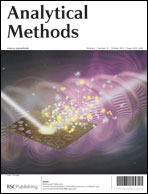In this study, two types of Danshen from different growth years were discriminated and identified by a three-step infrared spectroscopy method (Fourier transform-infrared spectroscopy (FT-IR) coupled with second derivative infrared spectroscopy (SD-IR) and two dimensional correlation infrared spectroscopy (2D-IR)). Though only small differences were found in the FT-IR spectra of the samples, the positions and intensities of peaks at around 1635 and 1055 cm−1 could be considered as the key factors to discriminate them. More significant differences were exhibited in their SD-IR spectra, particularly the significant absorption bands attributed to polysaccharides and phenolic acids. The visual 2D-IR spectra provided dynamic chemical structure information of Danshen samples, which present different particular auto peak clusters in the range of 1000–1160 cm−1 and 1430–1700 cm−1, respectively. Furthermore, twenty different samples including ten of each herb were also successfully classified by soft independent modeling of class analogy (SIMCA). This study offers a promising method inherent with cost and time savings to characterize and control the quality of extremely similar and complicated herbal medicines like Danshen.

You have access to this article
 Please wait while we load your content...
Something went wrong. Try again?
Please wait while we load your content...
Something went wrong. Try again?


 Please wait while we load your content...
Please wait while we load your content...